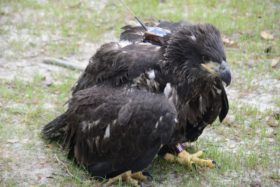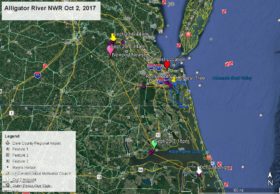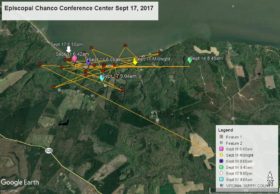A Day of Hope
Azalea Visits Sawyer Lake Again on Jan 30
February 1, 2010Azalea Leaves Alligator River NWR
February 2, 2010


Feb 1, 2010. A day of hope and some promise. Both the adults have been busy today putting pine straw under their egg. Compare the photos from today with those of yesterday. Yesterday the egg was layed on a level layer of snow with just a few sprigs of pine straw about. Today the pocket is 3 or 4 inches deeper and filled with pine straw – green pine straw, which means they have been bringing it to the nest today.
Lots of questions about why the adults are not incubating the egg all the time. Eagles usually lay their eggs about 2 to almost 4 days apart. The eggs usually hatch 1 to 3 days apart. The part time incubating slows the very early development of the embryo, thus the closer hatching dates. This is a very experienced pair of eagles. They have raised 12 eaglets to fledging age and have another at the Wildlife Center of Virginia. Trust them. They know what they are doing better than we do.




10 Comments
thanks for the update. we all hope the egg remains viable. i’ve watched off and on several times today, but have not seen them turn the egg, when yesterday they did so several times. am i just missing the turning or is this normal behavior? thanks, ray
I am so thrilled to be able to read this from a someone who knows about eagles. The chat part on these sites can be confusing with everyone asking and not knowing who’s answering whom. I will continue to follow this blog and learn much from you. Thanks for putting so much effort into it. The eagles are beautiful, do you know how old they are?
again thanks, Dee
Reese,
Those were comforting words, thanks so much. You also cleared up some confusion I was having with the incubating the egg. You are the expert. Like you said, we should trust the eagles.
Thanks so much for all you do.
Judy
Reese, thanks for everything! Like Dee, above, I can’t keep things straight on the new chat. It’s great to know that you are here/there for all of the IMPORTANT questions! I always learn so much from you.
Reese
Thank you so much for sharing your knowledge with us. I do trust our mom and dad completely.
I am just wishing for them to have a nice healthy family.
Thanks for all your info. The chat rooms can be a bit confusing on that. I sincerely hope the egg will remain viable and more eggs will follow. I love this cam.
Thanks again,
Margy
Reese – Thank you so much for the update. Most of us have a very warm spot in our heart for this pair and their offspring. (I am sure you know what I mean.) We will always have hope that all good comes to this pair. I so admire you and all you do for the good of wildlife.
Who else knows more than Reese? My only possible answer would be Mom and Dad eagle. As long as they continue to roll, sit on and take care of this little egg then I will continue to have faith that one day we will see a little pip hole, a little crack and that incredible site of Mom and Dad looking so proud at another little fuzzy bobble head.
Thank you for giving us hope.
Marianne
Reese,
My students were so happy to read your response this morning. THANK YOU for your comforting wisdom. We were watching the nest all day today and they are absolutely fascinated with the process. A few are already gunning for your job!
Thank you,
Renee
WOW! Just can’t say enough about this website. The camera and the operator are exceptional this year. I have learned a lot about eagles from this site. We have a pair of eagles where we live at Lake Cumberland in Kentucky that we watch constantly. This site has helped understand them a little more. Keep up the great work!
This is so much fun to follow. If everyone on chat would just go to the links and read what you have to say, the repetition would not exist but as a novice myself from last year and learning where to go, i understand. Ya’ll are doing great Reese. I hope this egg makes it, we should call it “snowball” if it does but, how do you know this is in fact the first egg and the first eaglet to hatch?